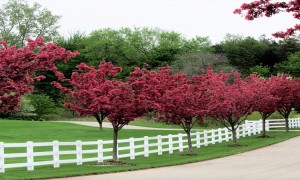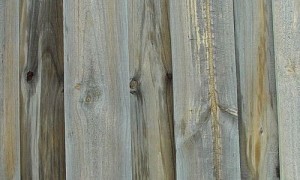By Chelsea McGrath
There’s something about a fresh coat of paint or stain that really helps a fence pop! Keeping a fence painted or stained also helps maintain the condition of the fence so you can enjoy it for years to come. Besides providing security, a good fence can also offer pleasant curbside appeal.
On the other hand, a worn, damaged fence can be an eyesore. And then there’s the dread of having to replace a part or even the entire fence because of on-going wear and tear, which could be costly. Fortunately, a bit of easy maintenance can go a long way toward keeping your fence in good shape.
The simplest way to maintain a wood fence is with paint or stain. Covering your fence with a protective coating helps in a number of ways including:
- Preventing sun and other weather damage
- Keeping the posts from excessive drying or cracking
- Keeping the wood from being damaged by mold and mildew
- Helping to lengthen the lifespan of the wood
Getting Ready for the Project:
As you prepare to embark on your fence restoration project, you might want to begin by taking a walk around your fence-line. Ask yourself the following questions as you inspect your fence. The answers to these questions will dictate your next steps, and help you to craft your shopping list.
- What’s the square footage of the fence?
- Are you are going to be painting/staining one or both sides?
- Are there some severely damaged post slats that might need to be replaced before beginning the painting or staining?
- What materials will you need to purchase prior to beginning?
- brushes appropriate for the type of cover you are applying
- paint trays and paint cups
- gallons of exterior paint and primer – the amount needed dependent on size of fence
- if using stain, consider purchasing enough gallons to apply at least two coats
- scrapers
- stir sticks
- tarps
- sandpaper to smooth out rough spots in the wood
- screws and screwdriver to fasten loose or replace missing screws
The more prepared you are at the start of the project of painting a fence, the smoother the task should go!
Paint or Stain
Deciding on whether staining or painting a fence is better, the answer is basically up to you. Both have advantages.
Paint
Paint offers you the flexibility to match colors for aesthetic appeal. For instance, if you want the fence to match exterior building colors or enhance the landscaping, using paint may be more effective for this purpose.
Paint covers the wood rather than being absorbed into it like stain. There are two types of paints to use on a wood fence: semi-transparent and solid. Semi-transparent offers a painted cover with the wood grain showing through. With a solid paint, the wood grain is covered by the smooth color finish.
For previously painted fences, there is often a bit more work required to get a good finish on the wood.
The best way to maintain it is by the following steps:
- You should scrape the old, peeling paint first. This is the biggest difference in painting versus staining, but it’s an important step. Scraping helps to keep the new paint layer laying smooth and adhering better to the wood surface.
- Wash the fence off with water to clean out the dirt, remove loose old paint chips, and provide a clean work surface.
- Cover any proximate surfaces you don’t want to have accidentally painted!
- When painting a fence, be sure to prepare the surface with a paint primer. A few considerations to keep in mind with regard to primers are to:
- Be sure the primer will work with the paint you are going to use on the top-coat for the fence. Not all primers work with all paint types. So once you choose the paint, check that the primer is compatible with it.
- Check that the primer provides protection for what you may need, such as mold
- Be sure to apply the primer as directed and allow it to dry completely before starting the top-coat layer. This will insure a more even finish, avoid moisture pockets, and help with the effectiveness of the primer coat.
- Apply the paint top-coat. Consider painting a fence with a brush rather than sprayer for a smoother, more complete application.
Stain
If you are considering staining the wood fence instead, the process is a little simpler. For instance, you won’t need to scrape off the old stain or apply a primer. If you purchase a stain with primer and/or water-proofer in it, that step can be removed from the process completely.
Stain is nice for providing a natural look with the grains of the wood exposed. The most important point to keep in mind with stain is to apply it in the direction of the grain.
If you are using colored stain, be sure to have it mixed well before applying. Also, as stain absorbs into the wood rather than covers it, you might want to do more than one coat for stronger protection.
Don’t Want to Deal with Painting a Fence?
If staining or painting a fence isn’t a task you have time for, consider replacing your wood fence with a fence made of another type of material. There are many maintenance-free alternatives that don’t require painting or staining including metal, vinyl, aluminum, and composite fencing.
These options may be more expensive than a traditional wood fence though might last longer and require less time to maintain over the years. However, putting these types of fences up could require a bit more work up font. For instance, most metal and vinyl pieces come in panels which could be heavy or awkward to install alone. If you have an uneven or hilly property, installation might require a professional for the best result.
Resources:
http://www.paintquality.com/en/advice-and-tips/faq/exterior/difference-between-paint-and-stain
https://www.familyhandyman.com/garden-structures/fences/maintenance-free-fencing/view-all







Well, if you have decks or fences then you should stain them properly. I suggest you go for stain because it cares your deck or fence from internally and it is capable of loading extra traffic from the external side.